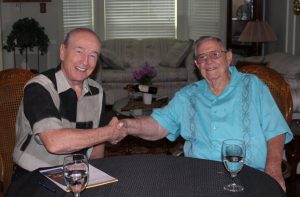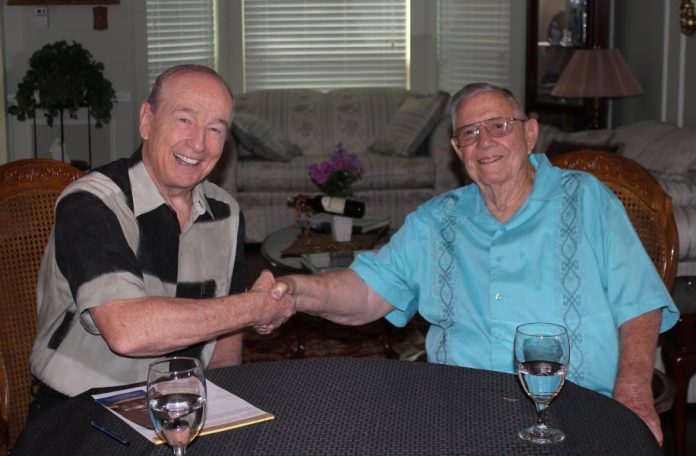
The reason I love doing these interviews is because I meet so many interesting people, each of whom has made an impact on their community, their city, their state, and/or their country.
When I first learned about Watson Crumbie, the subject of this interview, I did my usual research to include in this article and to assist me in asking questions for the video portion, which accompanies this story. What I discovered was mind-boggling! This World War II and Korean War veteran, a resident of Robson Ranch, has a story that can only be told by the man himself. Therefore, here it is in his own words.
“I was 16 years old when Japan attacked Pearl Harbor. Two of my close friends were killed aboard the USS Arizona, as well as my future brother-in-law. Another friend was in the Bataan Death March. In August 1943, on my eighteenth birthday, I joined the Marines to avenge their deaths and in June 1944 I landed with the 2nd Marine Division in the invasion of Saipan as Infantry Assault Demolitionist. I carried a twenty pound satchel of high explosive to destroy enemy positions. After twenty straight days of frontline combat, there were only 200 of the original 1000 left. The advantage of capturing Saipan was that it gave us a land base from which our bombers could bomb the Japanese homeland.
“The battalion was then sent to Guadalcanal to become a part of the 6th Marine Division. The 6th Marine Division invaded Okinawa on April 1st 1945. During the battle for Okinawa, the 29th Marine regiment suffered more casualties than any regiment in Marine Corps history for a single battle. I fought the entire 82 days it took to capture Okinawa as an Infantry Assault Demolitionist, except for 36 hours when I was hospitalized with a concussion.
“We were to invade Japan in March 1946 with the expectation of over one million casualties. It was a major factor in President Truman’s decision to use the atom bomb to end the war. After Japan surrendered we were sent to China to accept the surrender of Japanese forces and became involved in the civil war between Nationalist and Communist forces. Five months after WWII ended, I February 1946, I was honorably discharged
“War with Russia was inevitable and I did not want to go to war with Russia as a Demolitionist, so I enlisted in the reserves to become an artilleryman. In June 1950, North Korea invaded South Korea. I had been married ten days when called to active duty, and six weeks later I was in combat as a Staff Sergeant with the 1st Marine Division in Korea, landing at Inchon South Korea with some of the highest tides in the world. By cutting across the peninsula, to cut off the supply lines to the North Korean army, we changed the tide of the war in just days.
“We were then sent into North Korea as a United Nations Force to reunite all of Korea. As we neared the border with China we were suddenly attacked by overwhelming numbers of Chinese Communist forces. What followed is known as the “Most epic battle in Marine Corps history.” We were at a reservoir called Chosin, in North Korea, thirty miles from the border with China and seventy five miles inland. To survive, we would have to fight through 120,000 of the enemy in temperatures as low as 60 degrees below zero, without sleep, food or water (since everything was frozen). The Pentagon wrote off the 1st Marine Division and President Truman considered using the A bomb. A National Day of Prayer was declared by President Truman.
“It took us thirteen days, but we did it, to reach a seaport where the US Navy was waiting to evacuate us in the greatest sea evacuation in US history. We inflicted so many casualties on the ten Chinese divisions that two were never heard from again. The original 15,000 UN force had suffered 12,000 casualties, both enemy inflicted and weather related. As a result of the battle, which began at a reservoir called “Chosin,” which had so few survivors, we are known today as “THE CHOSIN FEW.” http://www1.cbn.com/700club/chosen-few. A documentary, “The Battle of Chosin” by The American Experience, will air for the first time on November 1st at 8 p.m. on PBS, http://www.pbs.org/wgbh/americanexperience/films/chosin/.
“I am the President of the North Texas Chapter of The Chosin Few, and the Chairman of a $700,000 monument to the memory of all UN Forces, which is under construction at the National Museum of the Marine Corps in Quantico, VA. Having fought in a total of seven battles, without being wounded, I probably have more time in front line combat that anyone you will meet. I give thanks to our Lord every day and still ask WHY?”
Watson Crumbie is one of the many men and women that served our country valiantly and helped make us the most powerful and prosperous nation in history. They are what are proudly known as “The Greatest Generation.” Thank God for them!!
Bob Weir is a former NYPD officer, long-time Flower Mound resident and former local newspaper editor.















 GIF.gif)


